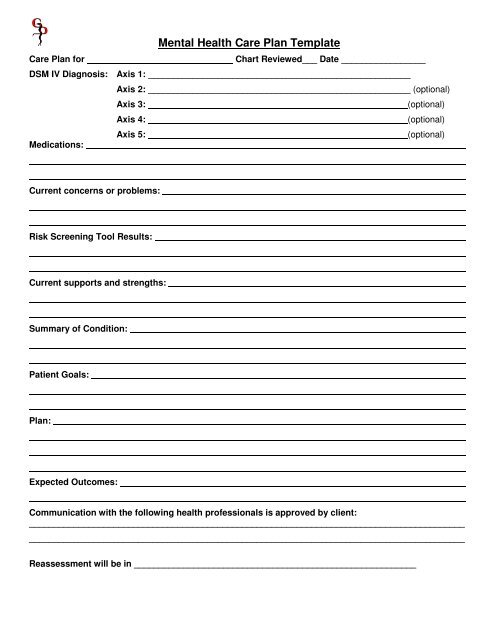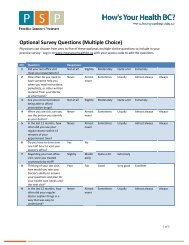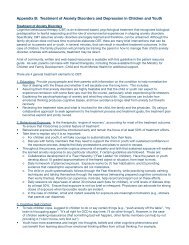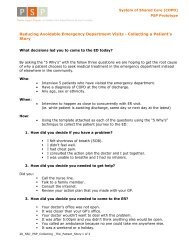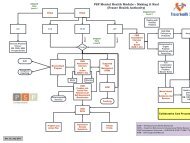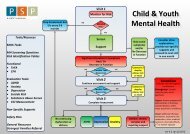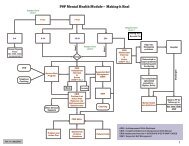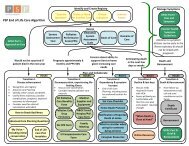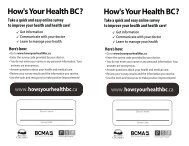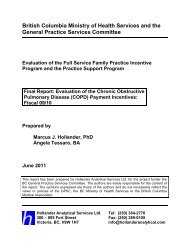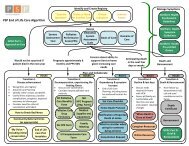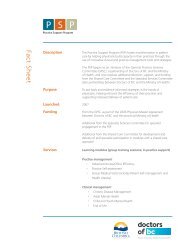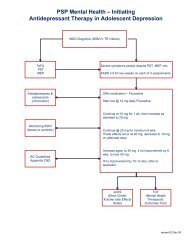Mental Health Care Plan Template - GPSC
Mental Health Care Plan Template - GPSC
Mental Health Care Plan Template - GPSC
You also want an ePaper? Increase the reach of your titles
YUMPU automatically turns print PDFs into web optimized ePapers that Google loves.
<strong>Mental</strong> <strong>Health</strong> <strong>Care</strong> <strong>Plan</strong> <strong>Template</strong><br />
<strong>Care</strong> <strong>Plan</strong> for<br />
Chart Reviewed___ Date _________________<br />
DSM IV Diagnosis: Axis 1: _____________________________________________________<br />
Axis 2: _____________________________________________________ (optional)<br />
Axis 3:<br />
(optional)<br />
Axis 4:<br />
(optional)<br />
Axis 5:<br />
(optional)<br />
Medications:<br />
Current concerns or problems:<br />
Risk Screening Tool Results:<br />
Current supports and strengths:<br />
Summary of Condition:<br />
Patient Goals:<br />
<strong>Plan</strong>:<br />
Expected Outcomes:<br />
Communication with the following health professionals is approved by client:<br />
________________________________________________________________________________________<br />
________________________________________________________________________________________<br />
Reassessment will be in _________________________________________________________
DSM-IV Multi-axial System<br />
Psychiatric Diagnoses are classified by the Diagnostic and Statistical Manual of <strong>Mental</strong> Disorders, 4th. Edition. Better<br />
known as the DSM-IV, the manual is published by the American Psychiatric Association and covers all mental health<br />
disorders for both children and adults. For each condition, it lists the diagnostic criteria, associated features, prevalence,<br />
course, familial patterns and differential diagnosis. <strong>Mental</strong> <strong>Health</strong> Professionals use this manual when working with<br />
patients in order to clarify and standardize diagnosis using a biopsychosocial perspective. Much of the information from<br />
the Psychiatric Disorders pages is summarized from the pages of this text. Should any questions arise concerning<br />
incongruence or inaccurate information, you should always default to the DSM as the ultimate guide to mental disorders.<br />
The DSM uses a multi-axial or multidimensional approach to classifying a patient’s mental disorder in order to help the<br />
clinician make a comprehensive and systematic evaluation. It helps organize and communicate clinical information and<br />
capture the complexity and individuality of a patient’s condition. It assesses five dimensions as described below:<br />
Axis I Clinical Disorders<br />
• This is what we typically think of as the diagnosis (e.g., major depressive disorder, schizophrenia, social phobia).<br />
It includes all the DSM diagnoses except Personality Disorders and <strong>Mental</strong> Retardation<br />
Axis II Personality Disorders and <strong>Mental</strong> Retardation<br />
• Axis II can also be used to indicate prominent maladaptive personality features and maladaptive defense<br />
mechanisms<br />
• Personality disorders are enduring, inflexible patterns of inner experience and behaviour (thinking, experiencing<br />
emotion, relationships, impulse control) that deviate markedly from the expectations of the person’s culture and<br />
lead to impairment in functioning. They include Paranoid, Antisocial, and Borderline Personality Disorders.<br />
Axis III: General Medical Conditions<br />
• Relevant as they may play a role in the development, continuance, or exacerbation of Axis I and II Disorders<br />
Axis IV: Psychosocial and Environmental Problems<br />
• Can affect the diagnosis, treatment, and prognosis of mental disorders<br />
• Examples are: stressful events in a person’s life such as death of a loved one, change in employment, family<br />
problems, economic difficulties and legal problems. These events are both listed and rated for this axis.<br />
Axis V: Global Assessment of Functioning<br />
• On the final axis, the clinician rates the person's level of psychological, social and occupational functioning in a<br />
given time period (current or highest in the past year). This is useful for tracking clinical progress as well as<br />
measuring the overall impact of the mental disorder. Scale is 0-100 and usually recorded in a 10-digit range e.g.<br />
51-60.<br />
ICD9 Psychiatric (DSM IV) Codes Commonly Used in General Practice:<br />
290 Senile And Presenile Organic Psychotic Conditions (Dementia)<br />
291 Alcoholic Psychoses<br />
292 Drug Psychoses<br />
293 Transient Organic Psychotic Conditions (Delirium)<br />
294 Other Organic Psychotic Conditions<br />
295 Schizophrenia<br />
296 Affective Psychoses (Bipolar disorder)<br />
297 Paranoid States<br />
298 Other Nonorganic Psychoses<br />
299 Psychoses With Origin Specific To Childhood (Autism)<br />
300 Neurotic Disorders (Anxiety, Phobia, OCD, neurotic depression)<br />
303 Alcohol Dependence Syndrome<br />
304 Drug Dependence<br />
305 Nondependent Abuse Of Drugs<br />
306 Physiological Malfunction Arising From <strong>Mental</strong> Factors<br />
307 Special Symptoms Or Syndromes Not Elsewhere Classified<br />
308 Acute Reaction To Stress<br />
309 Adjustment Reaction<br />
Specific Nonpsychotic <strong>Mental</strong> Disorders Following Organic Brain<br />
310 Damage<br />
311 Depressive Disorder, Not Elsewhere Classified<br />
312 Disturbance of Conduct, Not Elsewhere Classified<br />
313 Disturbance Of Emotions Specific To Childhood And Adolescence<br />
314 Hyperkinetic Syndrome Of Childhood (ADHD)


